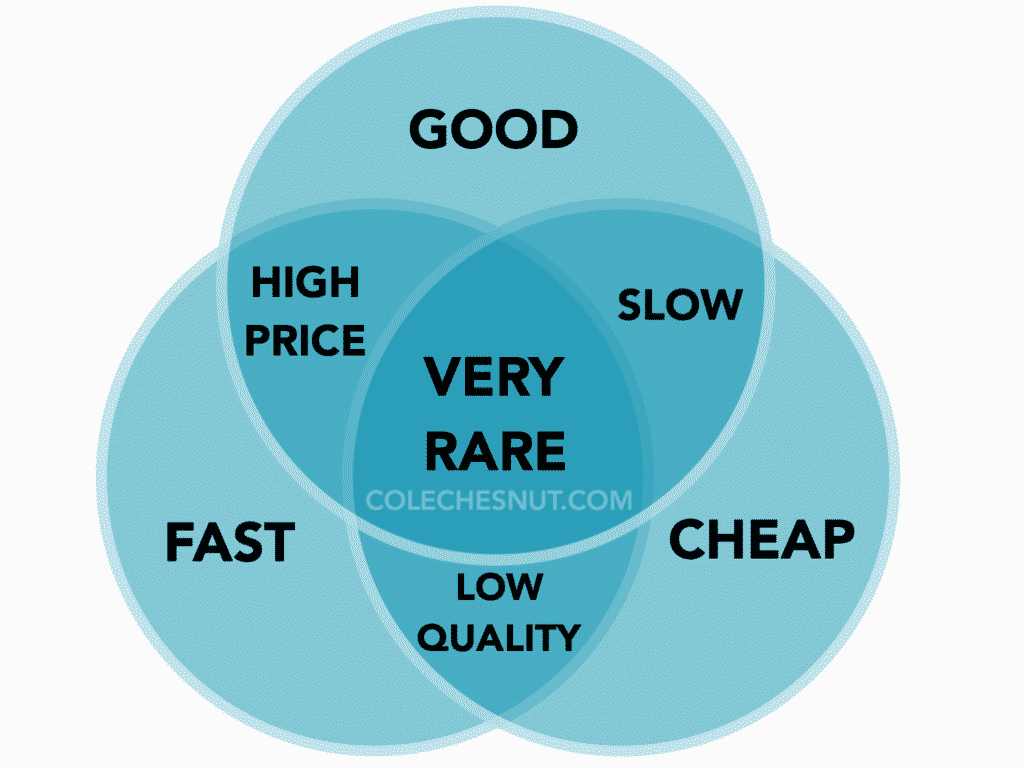Digging Into the “Good – Fast – Cheap” Ideal and Beyond

In my previous post, How to Find the Best Contractor for Your Construction or Remodeling Project, I mentioned the need to set priorities when planning a project, and showed this old saying that many contractors use as an example to consider;

That is not completely accurate for every situation, but may be somewhat useful as a simple thought process to figure out priorities.
This Venn diagram shows those “good – fast – cheap” dynamics in a more visual way;

Again,
Many people say that it is impossible to fulfill all three factors of good, fast, and cheap. I would rather say that it is very rare. It is especially difficult to achieve in custom work, but there are some cases in which all three factors can be achieved, such as in mass production where cost benefits can be realized from the economy of scale.
Triple Constraint Triangle
This is a related diagram that project managers should be familiar with; the “triple constraint triangle,” consisting of the sides being scope, cost, and time with quality in the center.

Simply explained;
1. The quality of work is constrained by the project’s budget, deadlines, and scope (features).
2. The project manager can trade between constraints.
3. Changes in one constraint necessitate changes in others to compensate or quality will suffer.Source: https://en.wikipedia.org/wiki/Project_management_triangle
For example, a project can be completed faster by increasing the budget or cutting scope. Similarly, increasing the scope may require equivalent increases in budget and schedule. Cutting the budget without adjusting schedule or scope will lead to lower quality.
That is a basic concept as taught by the Project Management Institute (PMI). Again, maybe not completely perfect, but helpful to understand.
There is some controversy about the validity of the triple constraint model, which is explained in this white paper, The triple constraint: a triple illusion.
Six Major Competing Project Constraints
From a more sophisticated project manager’s perspective, there are other competing project constraints. Cornelius Fichtner teaches, in his PM PrepCast video course, that scope, schedule, cost, quality, resources, and risk are some of the major project factors that need to be carefully planned and continually balanced.

Again, this is not a comprehensive or perfect analogy, but it is more useful for the management of complex projects than the previous diagrams that I showed.
For example, if a customer requests to increase the scope of a project, then other factors should be adjusted for balance. The most obvious is that the cost would likely increase. However, other factors also may be adjusted for balance, such as decreasing the quality (not preferable ideally, but that happens in reality), and/or increasing the schedule duration, etc.
In summary, having a more in-depth understanding of these various issues can lead to successful project management outcomes. If you’re interested in learning more, I recommend clicking on some of the links in this post.
My Experience
I am currently an aspiring Project Management Professional (PMP), which is to say that I am in the process of getting that certification from PMI. I plan to complete that by the end of February 2019. That process itself is a project that I will write more about in the future.
For several years, I have used PMI’s Project Management Body of Knowledge (PMBOK) as a framework for developing and adapting methodologies that are more specific to fit various situations, different types of projects, and different company cultures. I started doing this as an employee of one company, then progressed to consulting and improving several different companies.
I love to do this. Helping people get things done in the best way possible is really enjoyable. If you want my help, please let me know.
One Response
[…] good, fast and cheap dynamics in a visual way that makes sense to me. I also wrote a lot more about this topic on my blog if you’re […]